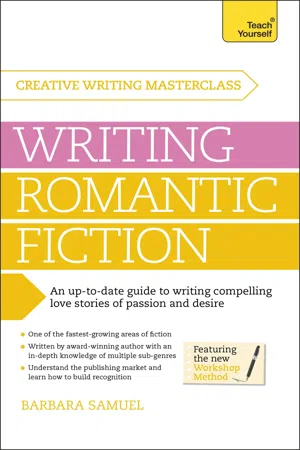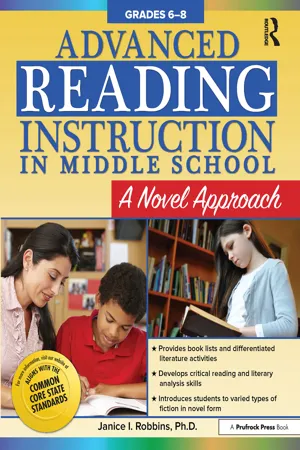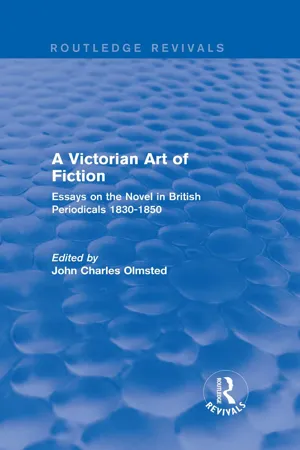Historical Romance Fiction
Historical romance fiction is a genre of literature that typically takes place in a historical setting and focuses on a romantic relationship as a central theme. These novels often feature strong, independent heroines and dashing heroes, and they provide readers with a blend of historical details and passionate love stories. The genre is known for its ability to transport readers to different time periods while exploring the complexities of human emotions.
6 Key excerpts on "Historical Romance Fiction"
- eBook - ePub
- Jerome De Groot(Author)
- 2009(Publication Date)
- Routledge(Publisher)
...We might, therefore, posit Historical Romance Fiction as something that is similarly part of this continuum and that could be used in a set of competing, possibly contradictory, and subversive ways. As Lisa Fletcher argues, ‘Historical Romance Fiction is constituted by an awareness of the instability of its narratological and ideological foundations’ (Fletcher 2008: 14). Of course, it also might be used to serve a set of conservative, traditional discourses. The association of women's historical writing with the romance is one of the reasons why it has been generally critically ignored (Wallace 2005: 150). Allied to this is the further issue that most of the fiction discussed in this chapter is popular, in genre and in market. Yet it seems clear that the historical version of the romance is an extremely important and a very particular type of genre. The notion of ‘distance’ is key to the romance (Wallace 2005: 153), and similarly ‘The setting of historical romance provides just that necessary mingling of “distance” and “reality” which allows the combining of “surrogate experience” and “wish-fulfilling motifs” that are crucial to the genre’ (Hughes 1993: 1). This has led to the historical romance being one of the most popular, long-running and widely read types of writing in the world. There are also sub-genres of the historical romance, in particular the ‘erotic historical’, which developed in the 1970s (Thurston 1987). The development of mainstream, relatively formulaic, Historical Romance Fiction is outlined by Helen Hughes (Hughes 1993: 2–3, 132–4). Having been normally what most historical fiction was called (from Scott to Flaubert), the increasing association of historical ‘romance’ with a particular type of sub-generic writing led to its marginalisation...
- eBook - ePub
Masterclass: Writing Romantic Fiction
A modern guide to writing compelling love stories of passion and desire
- Barbara Samuel(Author)
- 2014(Publication Date)
- Teach Yourself(Publisher)
...It won’t work. The first thing you have to have is belief.’ HISTORICAL ROMANCE This subgenre covers any novel set in a historical period. The most common eras are the Regency, Georgian and medieval periods, and such stories will nearly all be set in England, with perhaps some forays to as far away as France. The Victorian era is popular, too, and these stories may be set in England or America. American Westerns were dead for decades but seem suddenly to be having a resurgence. An era also in the ascendant is the early to mid-twentieth century, as more and more young writers are finding – through television shows like Downton Abbey – a passion for the times that their grandparents and great-grandparents had no interest in reading about. Historical romantic novels have been a mainstay for generations. Writers such as Victoria Holt, Daphne du Maurier and Anya Seton were publishing novels in the 1960s and 1970s and, with the explosion of big sexy historical tales by writers like Kathleen Woodiwiss in the 1980s, the genre has been very strong for decades. PARANORMAL AND FANTASY This huge subgenre may include characters like vampires, shape-shifters, witches and elves, and magic, fantasy or science-fiction elements of many kinds. Very popular in recent years is urban fantasy, about magical beings and ideas in city settings. Also enormously popular, especially among young adult readers, is the dystopian fantasy, where the stories are set after an apocalypse of some sort. (All of this subgenre is often within the Young Adult category, above.) EROTICA These romantic novels are centred upon the sexual connection between the protagonists. The big star here is 50 Shades of Grey, of course – one of the biggest bestsellers in history...
- Carrie Hintz, Eric L. Tribunella(Authors)
- 2019(Publication Date)
- Broadview Press(Publisher)
...In historical fiction, history actually impinges on characters and scenes rather than simply serving as a backdrop, and the historical period is rendered distinctively with concrete detail. Historical fiction sometimes, though not always, includes historical figures as characters, and it usually situates its main characters amid well-known historical events, such as the American Civil War or the Holocaust. Typically, in order to be termed a historical novel, the work needs to take place much earlier than the period of its composition. This creates a sense that the era represented is significantly different from that in which it was written. The greater the gap between the two periods and the more distinct the qualities of its place in time, the more clearly a work can be described as a historical novel. Simply being set before the life of the reader does not qualify a work as a historical novel. Last of the Mohicans by James Fenimore Cooper, illustrated by N.C. Wyeth, 1919. COMMON MOMENTS OR EVENTS IN HISTORICAL FICTION FOR CHILDREN The Use of Historical Settings in Children’s Literature Many classic children’s books have been works of historical fiction, such as Esther Forbes’s Johnny Tremain (1943), which is set during the American Revolution, and Elizabeth George Speare’s The Witch of Blackbird Pond (1958), set in seventeenth-century colonial America. Both of these books won the Newbery Medal, which has repeatedly been awarded to historical novels. In fact, more than twenty-five works of historical fiction have won the Newbery Medal between 1922, when it was first awarded, and 2016, making it one of the most consistently honored genres in American children’s literature. Some of the most prolific American writers for children, such as Ann Rinaldi and Avi, have made careers out of writing historical fiction, as have British writers such as Geoffrey Trease and Rosemary Sutcliff...
- eBook - ePub
Advanced Reading Instruction in Middle School
A Novel Approach (Grades 6-8)
- Janice I. Robbins(Author)
- 2021(Publication Date)
- Routledge(Publisher)
...Chapter 8 The Historical Novel DOI: 10.4324/9781003232902-9 History tells us what people do; historical fiction helps us imagine how they felt.—Guy Vanderhaeghe A historical novel, blending truth and fiction, takes the reader on a journey into the past. Unlike the historian, who seeks to uncover and report on the facts, the historical novelist seeks to tell the story behind the facts. The writer may choose to include some well-known people from the past but also invents a storyline that includes fictional characters and details of everyday life at the time. The historical novel is an emotional journey into the lives and times of the characters. In a good historical novel, the story details ring true, providing accurate historical context for the fictional story to be told. Seeking authenticity related to the time period, a writer conducts substantial preliminary research to capture real events and specific cultural references from the time. The readers feel like they are visiting a time and place that no longer exists but was a place where real people lived long ago. In the novel, readers hear the voices of these people and learn about their perspective on the times in which they lived. A good historical novelist stays true to the dialogue of the time, while still recognizing the need to support the understanding of the contemporary reader. The novelist knows that the language used in the novel may need to veer away from true authenticity, thus enabling today's readers to be able to conceptualize what is happening in the story. So, for example, a writer using an 1877 magazine as a historical source of information might have found this commentary about how schools might do a better job of educating young girls: A great many "betrothed maidens," we are sure, would be glad of such an opportunity of improving their knowledge of domestic affairs...
- eBook - ePub
A Victorian Art of Fiction
Essays on the Novel in British Periodicals 1830-1850
- John Olmsted(Author)
- 2016(Publication Date)
- Routledge(Publisher)
...Yet, like every other art, the historical romance has its principles; and it is by the right compreliending and skilful application of these principles, that its highest triumphs are to be gained. They are the same as those which have long been unfolded by the great masters of composition in relation to poetry and the drama; they are to be found applied by Sir Joshua Reynolds to the sister art of painting. Yet are they not attended to by the great mass of readers, and even by authors themselves, if we may judge by the frequent failures which are exhibited, little understood or frequently ne-glected. The first requisite of the historical romance is a subject which shall be elevated and yet interesting. It must be elevated, or the work will derogate from its noblest object, that of rousing the sympathetic passions, and awakening the generous feelings; it must be interesting, or these effects will be produced in a very limited degree. Readers of romance look for excitement; they desire to be interested, and unless they are so, the author's productions will very soon be neglected. This is universally known, and felt alike by readers and writers; but yet there is a strange misapprehension prevalent among many authors, even of distinguished talent, in regard to the methods by which this interest is to be awakened. It is frequently said, that the public are insatiable for novelty; that all home subjects are worn out; and thence it is concluded, that whatever is new must possess the greatest chance of becoming popular. In the desire to discover such novelty, every part of the world has been ransacked. Stories from Persia and the East have been plentifully brought forward; the prairies and savages of North America have furnished the subjects of more than one interesting romance; Russia, Poland, Italy, Spain, as well as France, Germany, Sweden, and the United States, have been eagerly ransacked to satisfy the craving of a generation seeking after something new...
- eBook - ePub
What Isn't History?
Selected Articles and Speeches on Writing History and Historical Fiction
- Ian Mortimer(Author)
- 2017(Publication Date)
- RosettaBooks(Publisher)
...Historical novels with soft-focus covers are even more of a worry. I opened one example last week to read on the first page about a captive twelfth-century heiress who was wearing a ‘gown’ which ended above her knee. I presume the author did not know that high-status women were expected not to reveal their legs or ankles at that time; I also presume the author would have been disappointed to be told this fact, as the heightened sexual tension of our heroine disporting her naked legs was clearly intended to be a key feature of the book. The fact is that genre historical fiction is more about escapism from our own time than about the past. As for the more literary end of the spectrum, where there is generally a greater attention to the ascertainable facts, there is a lack of clarity as to where the history ends and the fiction begins. This applies to highly imaginative historical novels, of course, but it also applies to well-researched, closely observed historical fiction. There is bound to be a mistake in there somewhere. But in many ways, the mistakes are not the point. Can one determine anything about the past with confidence from a novel? No. Any specific fact could be rooted exclusively in the author’s imagination. I have to say that the more you know your subject, the more you become aware that fiction is an inappropriate vehicle for describing past reality. Historical fiction can make suggestions: it can be used to raise valid historical questions, such as those posed in Josephine Tey’s The Daughter of Time. It can also be used to illuminate the deeper truths about human nature in the past that historical studies cannot encapsulate, such as the nature and importance of loyalty. But it cannot be used reliably to inform us about the actual past—for a novelist, by definition, does not take responsibility for the factual accuracy of everything in his or her book—and that taking of responsibility is crucial to the writing of history. Literary tools 1...





